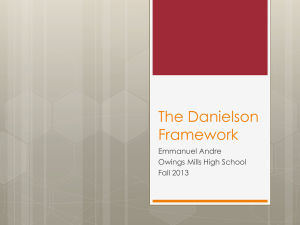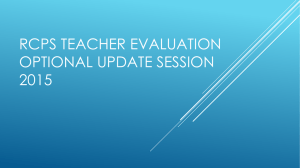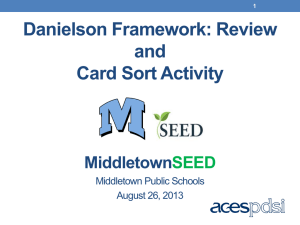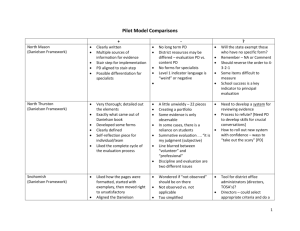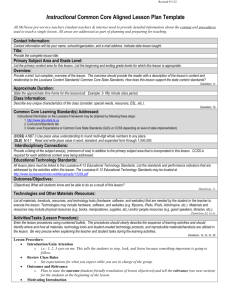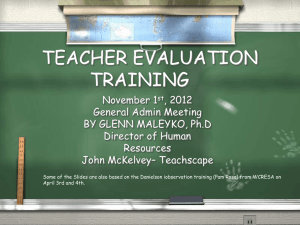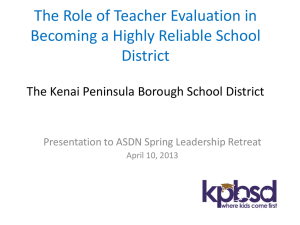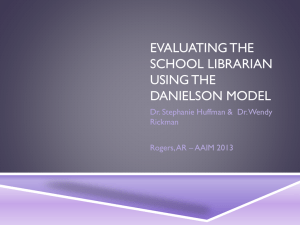Danielson Presentation 5/30/12 Symposium
advertisement
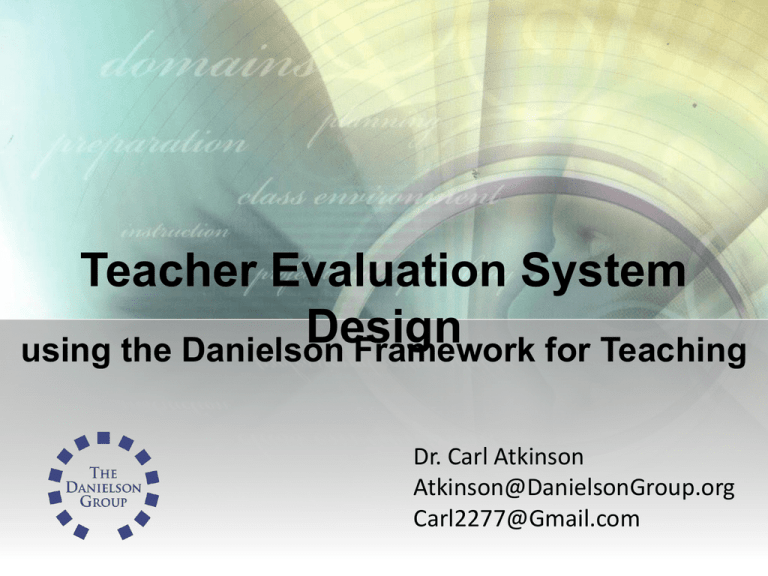
Teacher Evaluation System Design using the Danielson Framework for Teaching Dr. Carl Atkinson Atkinson@DanielsonGroup.org Carl2277@Gmail.com Purposes of Teacher Evaluation Quality Assurance Professional Learning Critical Elements of a Successful Teacher Evaluation System Teacher Professional Development Evaluator Training and Certification Instruments and Procedures Clear Definition of Good Teaching and Levels of Performance Domain 1 Planning and Preparation Domain 2 Classroom Environment 1a 1b 1c 1d 1e 1f 2a 2b 2c 2d 2e Demonstrating Knowledge of Content & Pedagogy Demonstrating Knowledge of Students Setting Instructional Outcomes Demonstrating Knowledge of Resources Designing Coherent Instruction Designing Student Assessment Creating an Environment of Respect & Rapport Creating a Culture of Learning Managing Classroom Procedures Managing Student Behavior Managing Physical Space The Danielson Framework for Teaching Domain 4 Professional Responsibilities Domain 3 Instruction 4a 4b 4c 4d 4e 4f 3a 3b 3c 3d 3e Reflecting on Teaching Maintaining Accurate Records Communicating with Families Participating in a Professional Community Growing and Developing Professionally Showing Professionalism Communicating with Students Using Questioning and Discussion Techniques Engaging Students in Learning Using Assessment in Instruction Demonstrating Flexibility & Responsiveness Levels of Performance UNSATISFACTORY BASIC PROFICIENT DISTINGUISHED Lack of Unsafe Harmful Unclear Unaware Poor Unsuitable Inconsistently Partial Generally Attempts Awareness Moderate Minimal Consistent Frequent Successful Appropriate Clear Positive Smooth Solid Seamless Subtle Skillful Preventative Leadership Students TEACHER DIRECTED SUCCESS STUDENT DIRECTED SUCCESS Observation is initiated Pre-conference Observation is conducted Observer analyzes observation notes Post-conference Traditional Observation Model Teacher Reflection Postconference (reflection) Observation is initiated Collaborative Observation Cycle Analysis by teacher AND observer Preconference (planning) Observation (Evidence collection) Evidence is organized and shared Observation is initiated Postconference (reflection) Collaborative Observation Cycle Analysis by teacher AND observer Preconference (planning) Observation (Evidence collection) Evidence is organized and shared “full” observation Focused “look for” walk thru Evidence collection walk thru There is a strong relationship between observation ratings and VAM (CCSR) Findings: • Ratings explained a significant portion of variation in VAM in reading and math • Relationship stronger in reading than in math • Teachers with high observation ratings had high VAMs (and viceversa) Why Choose the Danielson Framework for Teaching? Alignment with NJ Professional Teaching Standards Compatible with Common Core Standards Every component is researchbased Validated by the Chicago and MET research Critical Elements of a Successful Teacher Evaluation System Clear Definition of Good Teaching (WHAT) Instruments and Procedures (HOW) Training and Certification of Evaluators Professional Development for Teachers Training Tools Danielson Group Pricing Product Cost Danielson Framework for Teaching Evaluation Instrument (2011) $0 (yes, really) Enhancing Professional Practice: A Framework for Teaching (2007) $18.50-$27.95/book Customized to meet district needs, blended (online + face-to-face) options available $2850/day* +actual travel expenses Full day sessions *volume discounts apply for 10+ dates The Complexity of Teaching “After 30 years of doing such work, I have concluded that classroom teaching … is perhaps the most complex, most challenging, and most demanding, subtle, nuanced, and frightening activity that our species has ever invented. ..The only time a physician could possibly encounter a situation of comparable complexity would be in the emergency room of a hospital during or after a natural disaster” Lee Shulman, The Wisdom of Practice
